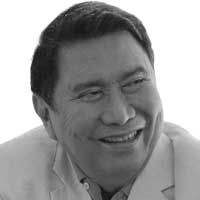Remembering Yolanda

Yesterday, Nov. 8, was the 8th anniversary of when Super Typhoon Yolanda (international name: Haiyan) devastated a big portion of the Visayas, particularly Leyte and Samar.
I write this piece so that the government and the people won’t make the same mistakes in the wake of Yolanda.
The country was not prepared for the strength of the super howler, and many lost their lives.
People who lived in communities that were on the path of the giant howler didn’t evacuate to higher ground; they didn’t understand the government announcements that there would be “storm surges” in many areas. Perhaps what should have been said was that tsunamis or huge waves would hit many places.
The Noynoy Aquino government pegged the fatality rate at 6,000 when estimates on the ground said more than 20,000 died.
The Eastern Visayas police director at the time was sacked for saying that the death toll would not be less than 20,000.
It was hypocritical of the government at that time to hide the real figures from the world.
I saw firsthand the destruction caused by the super typhoon.
My staff at the time in “Isumbong mo kay Tulfo,” some doctors and nurses of St. Luke’s Medical Center in Quezon City and I will always remember Yolanda.
It was a defining moment for each of us in that medical mission; modesty aside, it was our finest hour.
I had uncannily predicted Yolanda one month before it happened. I was with my staff distributing relief goods to the earthquake victims of Bohol when I got impressions of a coming dire event.
I told Alin Ferrer, my chief of staff at “Isumbong,” that our group should prepare for a tragedy much bigger than the 7.2-magnitude Bohol earthquake that toppled many buildings, including a centuries-old church. 222 people died due to the earthquake, with eight missing.
Our group stocked up on supplies: one ton of medicines, canned goods and other relief items like blankets and mats.
While Yolanda was battering Tacloban City and the rest of Eastern Visayas on Nov. 8, 2013, I asked tycoon Ramon S. Ang, who was then owner of Philippine Airlines (PAL), if he could provide us with a propeller-driven plane, and he said yes with alacrity.
Yolanda struck on a Friday; we were in Tacloban City three days later.
Our medical mission team consisted of 12 St. Luke’s-QC doctors and nurses led by Dr. Sammy Tanzo and eight non-medical people from “Isumbong,” headed by this columnist.
We were not prepared for the suffering that would haunt us for the rest of our lives as we landed at the Tacloban City airport.
As our plane circled Tacloban in preparation for landing, I saw from the air that the once-bustling city of 200,000 people looked desolate. Everything was a total mess.
I described in my column in another paper that it was as if an atomic bomb had been dropped on the city.
From the air, we could see people walking aimlessly like zombies, apparently due to shock.
Our medical mission immediately set up a makeshift hospital inside of the shell of a one-story building near the airport’s control tower.
Outside the building where we set up shop, non-medical members of our mission occupied a tent marked “Department of Health (DOH)” on top and turned it into an outpatient clinic.
A mass of humanity formed a long line; they were waiting for rides out of the city. It was an exodus. It seemed that everybody wanted to leave the city.
Not long after, patients started pouring in. They lined up, a crowd full of jostling people, three meters thick and half a kilometer long.
The crowd, separated from us by a fence guarded by soldiers, was waiting for their numbers to be called so they could board two Philippine Air Force C-130 planes – the only ones the country had at the time – that ferried passengers and relief goods from Tacloban to nearby Cebu.
One of our first patients was an 18-year-old girl with leg wounds. She writhed and shouted in pain as her wounds were being sutured.
The girl said she had lost her parents as the sea rampaged on land, destroying everything in its path. She survived by clinging to a tree trunk.
There were reports of rape our group had gathered from the crowd.
In less than two hours, our group ran out of medicines and other supplies. There were just too many people needing immediate medical attention.
Our prayers for more medicines were answered when somebody who came from Cebu aboard one of two of our Air Force cargo planes asked us where he could dispose of plenty of boxes of medicines.
Tanzo and I pointed to the tent marked “Department of Health.” Lo and behold, we had fresh medicines and bandages and plaster!
All of us silently cried in grief over the suffering of people.
An English-speaking family came to our tent asking for food. “We haven’t eaten for days, Mr. Tulfo and we’re very thirsty,” said the head of the family.
As we handed the family food and water, the man put down his food and said we should give his share to the people who were watching.
It is in times of crisis that the best – and the worst – in people come to the fore.
- Latest
- Trending



























